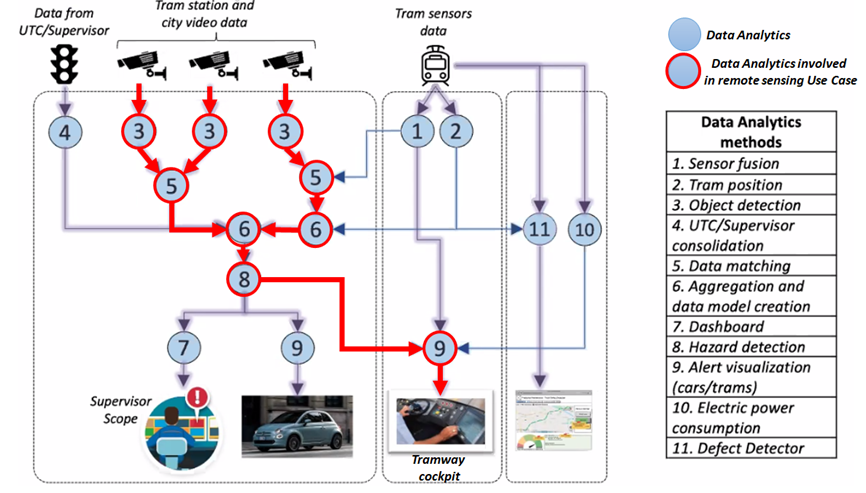Written by David Faura, Advanced Studies Engineer, THALES Research & Technology
The H2020 ELASTIC project addresses the entire compute continuum from the datacenter to the geo-distributed computing nodes, from the cloud to the edge. The purpose of the project is to develop the basic technological building blocks enabling the use of Information Technology (IT) domain software and hardware components in order to control the correct execution of applications and the correct management of operations in a geo-distributed infrastructure located in a smart city context.
To illustrate our point, we can take as an example one of the ELASTIC use cases: the edge/fog-enabled "Remote Sensing/Advanced Driver Assistance Systems (ADAS) from infrastructure" application for the city of Florence. This use case considers a distributed infrastructure of smart cameras and computing and communication networks placed along the tramway track. The objective is to be able to detect vehicle accidents beyond the capacity of the tramway sensors/radars and to prevent accidents in case of no visibility due to urban objects occulting vehicles or pedestrians. This new technology will have a major impact on the safety of the tramway by preventing future accidents through proactive braking of the tramway in case of an upcoming hazard detection while avoiding dangerous emergency braking. This will ensure a high level of protection for tramway passengers and the environment (pedestrians, bikes, cars, etc.).

Figure 1: ELASTIC Remote Sensing Workflows
ELASTIC is the first step toward an industrial compute continuum infrastructure, which has the ambition to manage industrial critical systems, a concept known as Operational Technology (OT). An industrial compute continuum is based on a computing infrastructure that can handle the IT/OT convergence while ensuring at the same time the high level of dependability required by OT systems, the flexibility of IT systems, and the resilience of fault-tolerant systems.
In order to address real-time constraints imposed by industrial systems, it is necessary for the underlying computing infrastructure to be able to process data and perform analyses as close as possible to the data sources while ensuring data privacy and data security. In addition, the computing infrastructure must be able to orchestrate and distribute micro-services, data-pipeline, cloud applications (legacy and new generation) and critical applications across the continuum, without interfering with the critical environment and fulfilling both Functional and Non-Functional Requirements (NFRs) required by critical applications.

Figure 2 : Next generation of Compute Continuum dedicated to the industrial domain
An essential step towards the management of an industrial critical system is to enhance IT infrastructure with distributed monitoring capabilities allowing real-time measurements of the computing environment and deployment decisions based on non-functional properties identified as critical. Work on this technical issue has already started within ELASTIC through the development of the NFR tools associated with the compute continuum resource management solution, which in ELASTIC is supported by the Global Resource Manage and the COMPs scheduler. These enhanced monitoring capabilities ensure that applications and hardware elements forming the compute continuum respect all the measurement points defined "at design time" by the non-functional requirements (time, energy, communication quality, data protection, safety and security). In the event of non-compliance with the usage domain the local monitoring components record and report any deviations to the global resources manager to provide safe and secure recovery decisions at the system level.
In conclusion, we consider that the industrial compute continuum must be composed of safe and secure edge/fog computing devices connected by efficient and resilient hybrid wired/wireless data networks. This can be achieved using hardware and software components which follow the tenets used in the development of critical systems (or at least for some parts of its infrastructure). Furthermore, the continuum must be able to guarantee different levels of confidence and isolation to ensure concurrent hosting of both critical and non-critical applications (mixed-critical properties). Finally, the continuum must be able to provide assurance evidences that the geo-distributed infrastructure is operating in a safe and secure state while ensuring that it does not create any unacceptable risks to humans, the environment or its mission (business impact).
Industrial compute continuum take away:
- Therefore the IOTIoT, EDGE/FOGedge/fog devices and their software components need to be Industrial domain grade. Who pays?
- NFR (incl. Safety and Security) must be handled at the platform level and not only at the application level.
- A joint safety and security approach is strongly recommended while remaining compatible with systems ranging from semi- to fully autonomous.
- Control and command will spread along the continuum transforming legacy embedded systems into communication hubs.
Pandora’s box is open!
